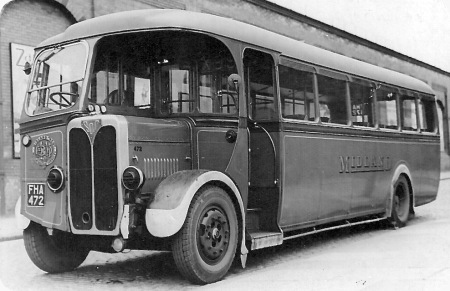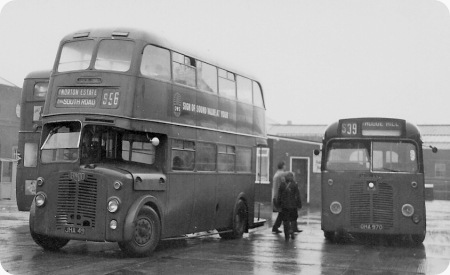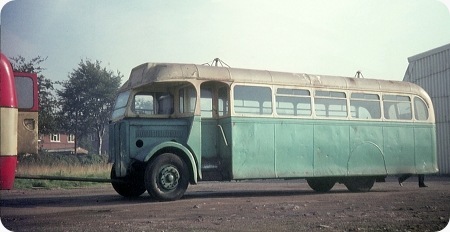Midland Red – SOS SON – FHA 472 – 472 – 2317

Photograph by ‘unknown’ if you took this photo please go to the copyright page.
Midland Red (Birmingham & Midland Motor Omnibus Co)
1939
SOS SON
Brush B38F
This uncredited wartime view of Midland Red FHA 472 (472 later 2317) shows it with masked headlamps and reflective mudguards. It was one of a large batch of SON’s built between 1935 and 1940 and is seen wearing its original lined and logo’d livery.
Incredibly, Midland Red then still favoured the use of bulkhead slot-in destination boards, even though the body shell seems to have provision for a small destination screen. These smart but archaic buses were rebuilt in the late 1940s by Hooton, Nudd Bros and Lockyer, but still minus a destination screen, which extended some of their lives until the late 1950s.

Just visible in an enlarged view is the stencilled bulkhead route number X99, which ran from Birmingham to Nottingham via Tamworth and Ashby-de-la-Zouch. This long route, according to a 1962 timetable, needed 2¾ hours to achieve, even as a limited stop service. Was the lack of destination board a wartime security measure? Was this view taken in Birmingham or Nottingham?
Photograph and Copy contributed by Paul Haywood
06/07/12 – 07:25
What was the purpose of the nearside mirror. Certainly at the angle it was set it would have been no use to the driver for looking down the nearside of the bus.
Could it possibly have been for him to look into the saloon to see if there were any passengers wanting to alight whilst the conductor was busy collecting fares and hadn’t given the stop signal?
Eric Bawden
06/07/12 – 07:26
Paul – this shot of FHA 472 was taken in Nottingham. The location is Glasshouse Street and the building in the background is Nottingham Victoria Station.
Michael Elliott
06/07/12 – 14:28
I suspect you’ve answered your own question, Eric, as that would be my guess too; it’s only a guess, though, and there will be people out there who can give us a definitive answer.
It isn’t clear from the photo how much flexibility (if any) there was on the mirror arm: in other words, could it have been turned to give a view of either the nearside of the bus or the platform at the whim of the driver?
Alan Hall
08/07/12 – 07:52
Another "Midland Red" gem!
Pete Davies
08/12/12 – 09:44
I may be repeating information mentioned elsewhere on the site but up until the 1st January 1958 there was no requirement for buses* to have a nearside mirror fitted. Observe bus photos up until the early 50’s, almost all with no nearside mirror! By the same token, there are lots of photos showing buses loading with the vehicle, unsurprisingly, some distance from the kerb. Knowing the delights (!) of driving a Regent II, what with its crash box, minimal power, heavy steering, curious pedal actions and cramped cab, I take my hat off to the guys that used to do a full shift in such a vehicle and all that without the assistance of a nearside mirror either!
*inc Goods vehicles, dual purpose vehicles and passenger carrying vehicle with more than 7 seats.
Berisford Jones
11/12/12 – 16:08
Seeing the SOS single deckers brought back an interesting memory. Just before Christmas 1953, my father drove the family straight six Daimler into the back of one somewhere between Malvern and Worcester. The force of impact disable the emergency door, and the front of the car was wedged under the bus against the back axle. I believe a crane was needed to eventually remove the car from under the bus.
I had two journeys on FEDDs. Once with an old aunt back to Perry Barr – I don’t remember where we had been. Later, a long ride – upstairs at the front from Birmingham to Sutton Coldfield on the No 107. They were still around Smethwick garage until 1960 – just missing being preserved.
jude5097
12/02/13 – 14:55
Memories!!! I lived twixt the 107 and Birmingham 5a route with the S76 and S67 passing my front door the latter were the buses from the Beggars Bush to Erdington Six Ways, one via Court Lane and one via Goosemoor Lane. All my life until National Service in 1954 they were serviced by AHA’s, CHA’s and DHA’s, nothing newer than that. The mirror was for the driver to see the passenger position generally, my grandad worked at Caryle Road and always commented that the Birmingham idea of a) the mirror in the cab looking back through the small glass window above the b) sliding glass communication window were far better ideas, particularly as he often was criticised by some drivers for moving the mirror when he cleaned the bus. I never thought of them as being ugly apart from the very early double deckers which seemed destined to take me to school in Sutton Coldfield for ever.
Bob Davis
Quick links to the - Comments Page - Contact Page - Home Page



